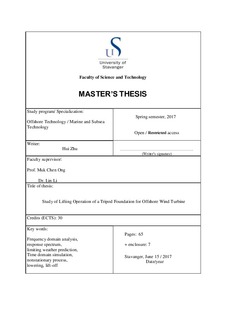| dc.description.abstract | Marine lifting operations play a key role in the installation of turbines and bottom-fixed foundations. Offshroe installations of the bottom-fixed foundations, tripod foundation in this study, are costly and risky due to the challenging environmental conditons and the bulkiness of the object. It becomes more and more challenging due to the tendency to intall larger turbines in the sites further away from shoreline. To minimize the risks and better prepare the operations, careful study and analysis are essential.
This thesis addresses numerical studies of the installation of tripod foundations using a heavy lift vessel (HLV). Both frequency and time-domain methods are applied in the study. Investigation is first carried out in the frequency domain using the response aptitude operators (RAOs) of the HLV. The wave induced rigid body motions of the vessel are calculated, represented by response spectrum and spectral moment. Thus, the vertical motion of the crane tip can be predicted, which is used as a criterion to find the limiting weather.
As the frequency domain method is based on the simplification of linear response, detailed numerical modelling and simulation of the installation system have been carried out in time domain to analyse the coupled dynamic system. The predicted limiting weather using frequency domain method is firstly verified in time domain by running stationary simulations. It is found that the predicted limiting sea states are inaccurate. The calculated limiting 𝐻𝑠 (significant wave height) is underestimated with 𝑇𝑝 (spectral peak period of the wave) approaching the natural periods of the installation vessel.
During the lifting operations, some potential critical events may be encountered, such as slack wire or re-hit, collision with the lifting vessel due to excessive motions of the tripod. To identify the potential risks, nonstationary simulations are conducted with emphasis on two lifting scenarios, the lift-off and the lowering phases. Moreover, comparative studies in response using two types of installation vessel, the HLV and the Jack-up, are investigated for the lowering process. Furthermore, sensitivity study on various hoisting speeds is also performed for the case onboard lift-off.
It is found that the wire tension and response of the tripod using the jack-up are relatively smaller, during the lowering process in the selected sea states, than the case utilizing floating vessel. Especially for the lowering in air, huge difference exists between the two types of installation vessels and barely any tripod motion is induced for the jack-up case thanks to the great bottom-fixed stability. Compared to the onboard lift-off, it turns out that there would be much more challenges for the lift-off from barge. Under the considered wave condition, the onboard lift-off operation can be smoothly implemented while the operation from the barge experiences snap load and re-hit. | nb_NO |
